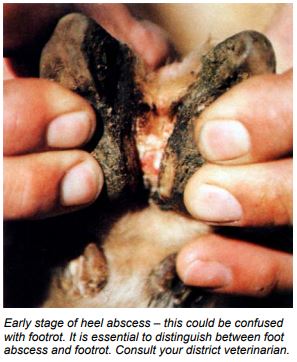Wet ground leads to foot abscess risk in sheep
 PRODUCTION ADVICE - JUNE 2020 - ANIMAL HEALTH
PRODUCTION ADVICE - JUNE 2020 - ANIMAL HEALTH
By Scott Ison
District Veterinarian
P: (03) 5881 9917 | M: 0427 362 003 | E: scott.ison@lls.nsw.gov.au
Adapted from NSW DPI Primefact: Foot abscess in sheep

Foot abscess is a serious disease in sheep. In terms of severity, its effect on welfare and productivity can be equal to virulent footrot.
It causes severe lameness in one or more feet and can result in a marked loss of condition as affected animals cannot move around to graze.
Rams and ewes may be unable to mate, and in severe cases, death may occur. Ewes affected in late pregnancy may develop pregnancy toxaemia and die, while those affected during lambing will lose of their lambs.
To prevent foot abscess, you need to avoid its predisposing causes, such as over-fatness and wet, muddy ground.
Adopt management practices to prevent sheep becoming over-fat, especially pregnant ewes. This may also help to avoid other problems like pregnancy toxaemia.
Avoid putting pregnant ewes in muddy conditions, including yards and laneways, even for short periods. In wet seasons, try to avoid putting pregnant ewes onto cereal crops until after lambing, as the ploughed conditions are ideal for developing dermatitis of the feet and subsequent heel abscess.
If these paddocks must be used, try to allow access to dry areas such as roads, large dam banks or herbicide-sprayed sheep camps where sheep have the chance to dry their feet.
If sheep must be yarded at these times, such as for pre-lambing drenching or other operations, dermatitis can be controlled by foot bathing the sheep in 10 per cent zinc sulphate as they leave the yards.
If permanent yards are waterlogged or muddy, use portable yards and footbaths to avoid making the dermatitis worse, especially when working with late pregnant ewes. Seek advice from your veterinarian on what treatments to use.
Foot abscess can often resemble footrot. Contact a veterinarian if you suspect footrot .